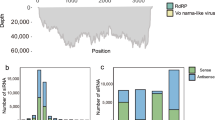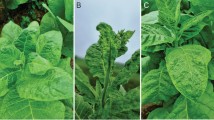Abstract
Diseases associated with tomato spotted wilt orthotospovirus (TSWV) are a serious threat to vegetable production worldwide. In 2019, leaf necrosis disease was observed on cucumber plants in Fukushima Prefecture, Japan. TSWV infection was identified in the diseased plants by immunostripe tests and RT-PCR analysis. Sequencing of the complete genome of this TSWV strain showed the highest identity with previously characterized TSWV isolates, and we therefore designated the cucumber-infecting variant as TSWV-Fukushima:cucumber 2019 (TS-FC19). Phylogenetic analyses based on the intergenic regions revealed that TS-FC19 and other TSWV isolates collected from the same area clustered in a distinct clade. Cucumber plants inoculated with TS-FC19 produced leaf necrosis symptoms, whereas other TSWV strains did not induce severe symptoms in this host. Together, our findings indicate that the cucumber leaf necrosis disease in Fukushima Prefecture is caused by a new strain of TSWV that appears to have evolved locally. This is the first detailed report on the biological characteristics of a cucumber-infecting TSWV.



Similar content being viewed by others
References
Abadkhah, M., Koolivand, D., & Eini, O. (2018). A new distinct clade for Iranian tomato spotted wilt virus isolates based on the polymerase, nucleocapsid, and non-structural genes. Plant Pathology Journal, 34, 514–531.
Bezerra, I. C., Resende, R. D., Pozzer, L., Nagata, T., Kormelink, R., & de Avila, A. C. (1999). Increase of tospoviral diversity in Brazil with the identification of two new tospovirus species, one from chrysanthemum and one from zucchini. Phytopathology, 89, 823–830.
Butković, A., González, R., & Elena, S. F. (2021). Revisiting Orthotospovirus phylogeny using full-genome data and testing the contribution of selection, recombination and segment reassortment in the origin of members of new species. Archives of Virology, 166, 491–499.
Ciuffo, M., Kurowski, C., Vivoda, E., Copes, B., Masenga, V., Falk, B. W., & Turia, M. (2009). A new tospovirus sp in cucurbit crops in Mexico. Plant Disease, 93, 467–474.
de Haan, P., Wagemakers, L., Peters, D., & Goldbach, R. (1990). The S RNA segment of tomato spotted wilt virus has an ambisense character. Journal of General Virology, 71, 1001–1008.
de Haan, P., Kormelink, R., Resende, D., van Poelwijk, F., Peters, D., & Goldbach, R. (1991). Tomato spotted wilt virus L RNA encodes a putative RNA polymerase. Journal of General Virology, 72, 2207–2216.
Feng, M., Cheng, R., Chen, M., Guo, R., Li, L., Feng, Z., Wu, J., Xie, L., Hong, J., Zhang, Z., Kormelink, R., & Tao, X. (2020). Rescue of tomato spotted wilt virus entirely from complementary DNA clones. Proceedings of the National Academy of Sciences of the United States of America, 117, 1181–1190.
Fuji, S., Mochizuki, T., Okuda, M., Tsuda, S., Kagiwada, S., Sekine, K.-T., Ugaki, M., Natsuaki, K. T., Isogai, M., Maoka, T., Takeshita, M., Yoshikawa, N., Mise, K., Sasaya, T., Kondo, H., Kubota, K., Yamaji, Y., Iwanami, T., Ohshima, K., et al. (2022). Plant viruses and viroids in Japan. Journal of General Plant Pathology, 88, 105–127.
Hanada, K., Tsuda, S., Kameya-Iwaki, M., & Tochhara, H. (1993). Distinct properties of nucleocapsid of a watermelon isolate of tomato spotted wilt virus. Annals of the Phytopathological Society of Japan, 59, 500–506.
Hedil, M., & Kormelink, R. (2016). Viral RNA silencing suppression: The enigma of bunyavirus NSs proteins. Viruses, 8, 208.
Heinze, C., Letschert, B., Hristova, D., Yankulova, M., Willingmann, P., Karadjova, O., Atanassov, A., & Adam, G. (2001). Variability of the N-protein and the intergenic region of the S-RNA of tomato spotted wilt tospovirus (TSWV). New Microbiologica, 24, 175–187.
Inoue, T., & Inoue, N. (1972). Tomato spotted wilt virus occurred in Dahlia plant. Nogaku-kennkyu, 54, 74–90.
Karavina, C. & Gubba, A. (2017). Detection and characterization of Tomato spotted wilt virus infecting field and greenhouse-grown crops in Zimbabwe. European Journal of Plant Pathology, 49, 933–944.
Kato, K., & Hanada, K. (2000). A necrotic disease of chrysanthemum (Chrysanthemum morifolium Ramat) caused by tomato spotted wilt virus (TSWV) in Japan. Kyushu Plant Protection Research, 46, 61–65.
Kato, K., Hanada, K., & Kameya-Iwaki, M. (2000). Melon yellow spot virus: A distinct species of the genus Tospovirus isolated from melon. Phytopathology, 90, 422–426.
Kobatake, H., Osaki, T., Yoshioka, A., & Inoue, T. (1976). Spotted wilt disease of tomatoes in Japan. Annals of the Phytopathological Society of Japan, 42, 287–294.
Kormelink, R., de Haan, P., Meurs, C., Peters, D., & Goldbach, R. (1992). The nucleotide sequence of the M RNA segment of tomato spotted wilt virus, a bunyavirus with two ambisense RNA segments. Journal of General Virology, 73, 2795–2804.
Kormelink, R., Storms, M., van Lent, J., Peters, D., & Goldbach, R. (1994). Expression and subcellular location of the NSm protein of tomato spotted wilt virus (TSWV), a putative viral movement protein. Virology, 200, 56–65.
Kumar, S., Stecher, G., & Tamura, K. (2016). MEGA7: Molecular Evolutionary Genetics Analysis Version 7.0 for Bigger Datasets. Molecular Biology and Evolution, 33, 1870–1874.
Margaria, P., Bosco, L., Vallino, M., Ciuffo, M., Mautino, G. C., Tavella, L., & Turina, M. (2014a). The NSs protein of tomato spotted wilt virus is required for persistent infection and transmission by Franklinella occidentalis. Journal of Virology, 88, 5788–5802.
Margaria, P., Miozzi, L., Ciuffo, M., Pappu, H., & Turina, M. (2014b). The complete genome sequence of polygonum ring spot virus. Archives of Virology, 159, 3149–3152.
Margaria, P., Ciuffo, M., Rosa, C., & Turina, M. (2015). Evidence of a tomato spotted wilt virus resistance-breaking strain originated through natural reassortment between two evolutionary-distinct isolates. Virus Research, 196, 157–161.
Massumi, H., Samei, A., Hosseini Pour, A., Shaabanian, M., & Rahimian, H. (2007). Occurrence, distribution, and relative incidence of seven viruses infecting greenhouse-grown cucurbits in Iran. Plant Disease, 91, 159–163.
Okuda, M. (2016). Tospoviruses occurring in and outside Japan. Japanese Journal of Phytopathology, 82, 169–184.
Okuda, M., Takeuchi, S., Taba, S., Kato, K., & Hanada, K. (2002). Melon yellow spot virus and watermelon silver mottle virus: Outbreak of cucurbit infecting tospovirus in Japan. Acta Horticulturae, 588, 143–148.
Oliver, J. E., & Whitfield, A. E. (2016). The genus Tospovirus: Emerging bunyaviruses that threaten food security. Annual Review of Virology, 3, 101–124.
Rotenberg, D., Jacobson, A. L., Schneweis, D. J., & Whitfield, A. E. (2015). Thrips transmission of tospoviruses. Current Opinion in Virology, 15, 80–89.
Shimada, R., Okuda, M., & Uekusa, H. (2019). Characteristics of watermelon silver mottle virus (WSMoV) found in Kanagawa prefecture and reproduction of symptoms on cucumber caused by WSMoV. Japanese Journal of Phytopathology, 85, 108–111.
Soellick, T. R., Uhrig, J. F., Bucher, G. L., Kellmann, J. W., & Schreier, P. H. (2000). The movement protein NSm of tomato spotted wilt tospovirus (TSWV): RNA binding, interaction with the TSWV N protein, and identification of interacting plant proteins. Proceedings of the National Academy of Sciences of the United States of America, 97, 2373–2378.
Takeda, A., Sugiyama, K., Nagano, H., Mori, M., Kaido, M., Mise, K., Tsuda, S., & Okuno, T. (2002). Identification of a novel RNA silencing suppressor, NSs protein of tomato spotted wilt virus. FEBS Letters, 532, 75–79.
Turina, M., Kormelink, R., & Resende, R. O. (2016). Resistance to tospovirusus in vegetable crops: Epidemiological and molecular aspects. Annual Review of Phytopathology, 54, 347–371.
van Knippenberg, I., Goldbach, R., & Kormelink, R. (2005). Tomato spotted wilt virus S-segment mRNAs have overlapping 3′-ends containing a predicted stem-loop structure and conserved sequence motif. Virus Research, 110, 125–131.
Whitfield, A. E., Ullman, D. E., & German, T. L. (2004). Expression and characterization of a soluble form of tomato spotted wilt virus glycoprotein GN. Journal of Virology, 78, 13197–13206.
Acknowledgments
We thank the NARO Genebank for providing the TSWV-P2 strain.
Author information
Authors and Affiliations
Corresponding author
Ethics declarations
Human and animal rights
This article does not contain any studies with human participants or animals.
Conflict of interest
The authors declare that there is no conflict of interest.
Additional information
The GenBank/EMBL/DDBJ accession number for the sequence reported in this paper is LC652640, LC652641, and LC652642 (TS-FC19).
Rights and permissions
About this article
Cite this article
Kon, T., Watanabe, N., Ootake, H. et al. Occurrence and characterization of tomato spotted wilt orthotospovirus isolated from cucumber. Eur J Plant Pathol 163, 789–797 (2022). https://doi.org/10.1007/s10658-022-02515-9
Accepted:
Published:
Issue Date:
DOI: https://doi.org/10.1007/s10658-022-02515-9




